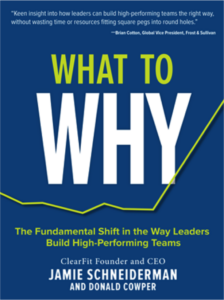
As a leader, how would you approach the following?
You recently joined a new organization to lead its marketing department, and you’ve started your first round of coaching sessions with everyone on your team. Up next is Carolyn.
Carolyn has some outstanding strengths. She’s a visionary thinker and an ideas machine who is constantly generating concepts for innovative marketing campaigns. But she also has some weaknesses. For example, she’s not always reliable when it comes to following through on her ideas.
Fork in the Road
What’s the best way to coach Carolyn in order to get her to make the kind of positive behavioral changes that will help you and your team reach its goals? Do you address her weaknesses and the ways she could make some improvements? Or do you essentially ignore her weaknesses and focus on the positives to nurture Carolyn’s strengths?
These questions lie at the heart of a dilemma faced by coaches everywhere. Traditional coaching, the kind most of us are familiar with, is based on improving weaknesses. But an approach focused exclusively on someone’s strengths is gaining popularity.
But is strengths coaching actually more effective? Is it really more likely to get someone like Carolyn to change for the better?
What the Science Says
A team of neuroscientists set out to study this question and recently published their results in Social Neuroscience. The team of researchers tested the two coaching styles on separate groups of undergraduates. For the positive style, they asked questions like “If everything worked out ideally in your life, what would you be doing in 10 years?” For the approach focusing on improving weaknesses, they would ask things like, “What challenges have you encountered or do you expect to encounter in your experience here?”
Then the researchers looked at what was happening inside the brains of the subjects using MRI technology, and discovered some revealing differences.
Revealing Differences
According to a Greater Good Science Center report from UC Berkeley, the positive approach lit up areas of the brain associated with the motivation to pro-actively pursue lofty goals. In contrast, the improving-weaknesses approach activated areas in the brain associated with stress and defensiveness, encouraging behaviour to avoid harm or loss.
As the Berkeley report writes, “Although the authors acknowledge that much more research needs to be conducted on the topic, their results offer a first glimpse at the neurological basis of why people coached by positive, visioning-based approaches tend to be more open emotionally, more compassionate, more open to ideas for improvement, and more motivated to pro-actively make lasting behavior changes than are those coached in ways that highlight their weaknesses.”
Indeed, more research needs to be done. In fact, as New York Magazine’s Science of Us recently argued, there is lots of research pointing to performance improvements from traditional coaching. However, these studies only compared traditional coaching against no coaching. What isn’t known is whether strengths coaching would result in even greater performance improvements. So although there’s no clear-cut answer, if you’re the type of coach who believes that strengths coaching is the best way to get someone like Carolyn to change their behaviour, you now have a little brain science on your side.
 If you haven’t already read What to Why, the free 20-minute eBook changing how leaders build top teams, which I coauthored with ClearFit founder and CEO, Jamie Schneiderman, you can download it here.
If you haven’t already read What to Why, the free 20-minute eBook changing how leaders build top teams, which I coauthored with ClearFit founder and CEO, Jamie Schneiderman, you can download it here.

